�

�
Economy Classic:
�Muscles Galore
�Why was production of the MGB V8 dropped after three years of half-hearted production? �
Was there behind-the-scenes skulduggery?
�
Roger Bell remembers, with affection, a tough car.
�
�
as published in British V8 Magazine, Volume XVI Issue 1, May 2008�
�
Re-printed unedited by exclusive written permission of "Motor".
�
This article originally appeared in their issue for the week ending December 18, 1982.�
�
�
THE TROUBLE with most MG sports cars was that they were too slow. Not even fanatical �
loyalists could claim crackerjack performance for the MGB, the most numerous of them �
all, when modest saloons of lesser capacity could comfortably outrun it, especially �
during the latter half of its long 18 year production life.�
�
The irony of the situation is that MG made three post-war attempts to produce really �
quick sports cars, and all three ended in commercial failure The oil-guzzling MGA Twin �
Cam (1958-60) was a recalcitrant, fragile machine, easily broken by abuse and poor �
petrol. Only 2,111 were made. While it lasted, though, no one could accuse it of being �
slow, with 0-60 mph acceleration in 9.1 seconds and a top speed of 115 mph. By late-'Fifties �
standards it was a 1600cc fireball.�
�
The same cannot be said of the miserable MGC (1967-69), BMC's meek replacement for the �
masculine Austin-Healey 3000. Its gutless and overweight engine denied it the sort of �
potency buyers expected of a 3-litre sports car and it was dropped. As an acknowledged �
failure right from the start, the "C" did well to reach the 9,000 mark, half of them �
fixed head GTs.�
�
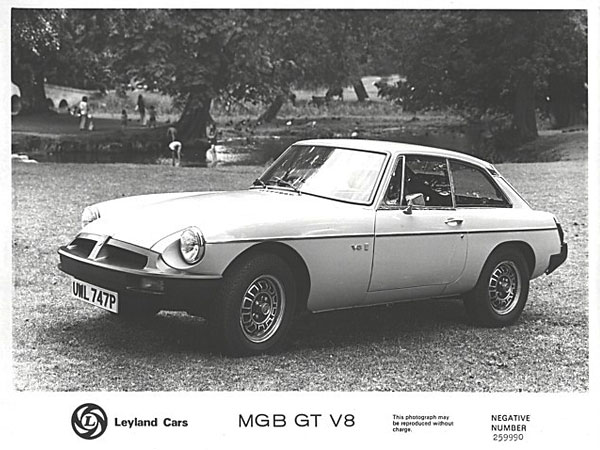
�
Leyland Cars: MGB GT V8 publicity photo - negative number 259990
�
� It was another three years before MG - now under British Leyland's tangled corporate � umbrella tried again with the BV8. Surely this would be third time lucky? Even though � the body and chassis were by then a decade old and the engine even older (yes, really), � the two in harmony seemed a perfect match. Here, at last was an Abingdon sports car with � real performance that its makers could be (and were) proud of, that customers would want, � that owners would cherish. It couldn't fail - yet t did! Cynics will say, not without � justification, that it was allowed to fail, which is strange considering that the BV8 � was arguably the most desirable post-war MG sports car and without question the quickest.�
��
Looking back on it, neither British Leyland nor the Press treated the V8 with the respect �
it deserved. Surprisingly lukewarm road tests (Motor's among them) didn't help, but they �
weren't the cause of the car's premature demise in 1976, after just over three years of �
half-hearted production following a gestation period that was almost as long. �
�
Probing the issue in his excellent book "MG" Wilson McComb quotes former Abingdon chief �
John Thornley. "There was a lot of behind-the-scene skullduggery... something about a �
limited license to build just so many of that enqine... I don't know why they canned it - �
whether they really wanted the engine for some other purpose or whether some stinker �
was jealous of it... it really was so good."�
�
So, why was it dropped? Officially, because the dwindling sales (production declined from �
1,069 cars in '73 to a mere 176 in '76). The rising cost of fuel in the wake of the energy �
crisis, which unfortunately struck just when the V8 was launched, inevitably depressed �
demand - but then, the BV8 was not a gas guzzler; its thirst for fuel was in fact quite �
modest. Given the right corporate support, the car might well have survived the fuel scare �
(as many others with heavier consumptions did) and continued its cut-price supercar role �
as Abingdon's flagship even though Type Approval problems prevented its sale in the �
all-important US market.�
�
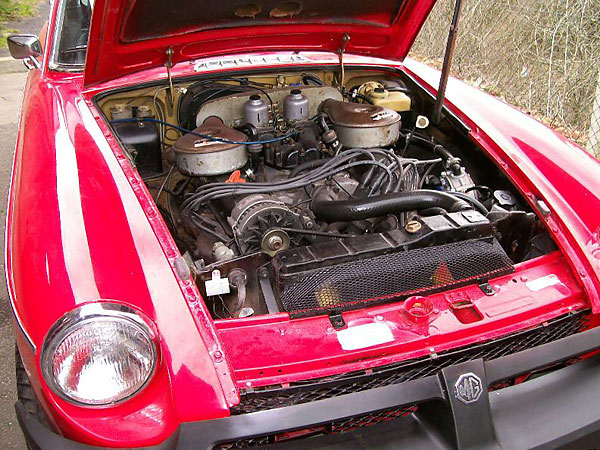
�
The V8's compact engine sat well back in the monocoque.
�
�
There's no doubt that BL did at the time need a healthy supply of the ex-GM Iight alloy �
V8 for the Range Rover and SDI 3500, announced in June 1976 a month before the MG was �
dropped. But that shortage soon reversed into a glut. As the four cylinder BGT - by now �
ludicrously slow compared with modern hot hatches like the Golf GTi - continued for �
another four years, until Abingdon's sad closure, the decision to drop the V8 was at best �
short sighted.�
�
Jealousy? There's plenty of evidence to indicate that BL's Triumph wing, arch rivals of �
MG before and after the Abingdon camp was drawn into the Leyland fold under Sir Donald �
(later Lord) Stokes, was favoured in certain corporate decisions at the expense of MG. �
For instance, the BGT was withdrawn from the US market to assist TR7 sales there (a decision �
that was poorly received by American MG buffs). It is also reasonable to assume that the �
projected Rover-engined TR8 (stillborn as it happened) would have had preference over the �
much older MGB V8 - and rightly so, as it was a generation younger and generally superior. �
Whether it would have been as successful as a US-legal MG, which had enormous untapped �
potential, is open to question. MG kudos was a strong marque weapon, as BL are rediscovering �
with the runaway success of the Metro quickie, which could well become the best-selling MG �
ever. What does seem clear, with the benefit of hindsight, is that the BV8, given the right �
support and development, could have done a lot more for its makers than they allowed.�
�
There is a silver lining to this cloudy tale. By dropping the car prematurely, BL did future �
owners a good turn by bestowing on the V8 the valued quality of scarcity appeal. Only 2,591 �
were built. Now, almost a decade on from its launch, the BV8 is one of the very few so-called �
modern classics that can seriously be considered not only as a hedge against inflation (if not �
a gilt-edged investment) but also a sensible, reasonably-priced slingshot for everyday motoring.�
�
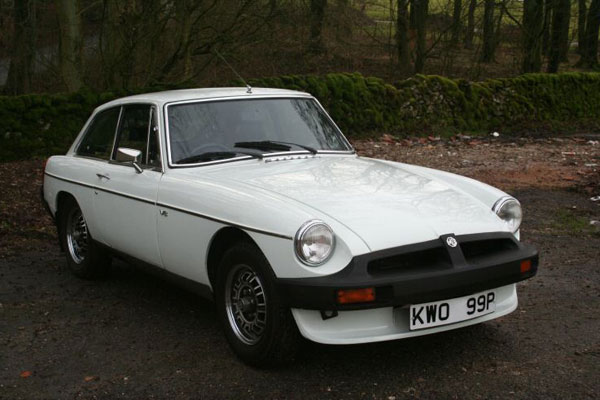
�
The "plus 2" part of the car was almost non-existent, as shown above,
�
but it was a civilized two-seater with generous luggage space.
�
� It was the disappointing "C's" failure that paved the way for the MG V8, though the story � really starts over a decade earlier with the launch of the MGB in 1962. The MGA's successor, � designed at Abingdon under Syd Enever's direction, with a little styling help from Pinin Farina � (the name was split in those days), was the first monocoque-bodied MG sports car, providing � better accommodation and comfort than the MGA even though it was shorter in wheel base and � overall length The capacity of BMC's pushrod ''four", long in the tooth even then, was increased � to 1,798cc, bumping up power to 95 bhp and torque to 107 lb.ft. Engine and transmission were � strengthened but the rest of the running gear was similar to the "A's" - live cart-sprung � rear axle included.�
��
Enjoying this article? Our magazine is funded through the generous support of readers like you!
�
To contribute to our operating budget, please click here and follow the instructions.
�
(Suggested contribution is twenty bucks per year. Feel free to give more!)�
�
The ragtop "B" was an instant success and MG production soured. It peaked again after the �
launch, in 1965, of the closed GT, one of the cleanest and best-proportioned cars to leave �
a British factory in the 'Sixties. Although nearly 2 cwt heavier than the open car, better �
penetration gave it a higher top speed (acceleration was little affected). With more weight �
over the back wheels, it also handled better. Considered as a civilized two-seater with �
generous luggage space it was, by the standards of the day, a marvelous eye-catching package, �
living up to its tag of "the poor man's Aston Martin" with real authority.�
�
In 1966 the BGT helped to push MG production to a record 40,000 cars, and BMC as they �
then were to the Number Two importer's spot (behind VW) in the States. Heady days! They �
were never to be repeated, though, as crash-safety and clean-air legislation, not to �
mention the rising tide of imports from the East, then began to erode MG sales.�
�
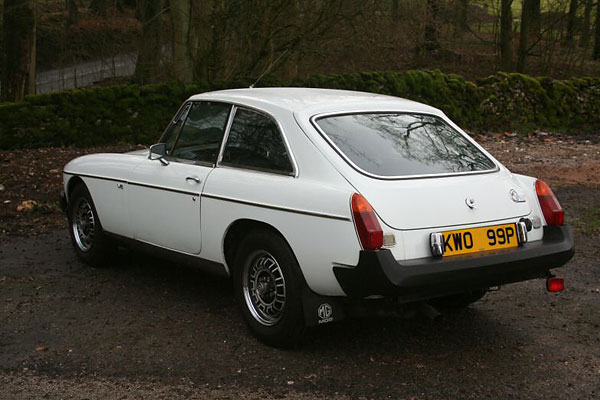
�
�
It was US legislation that finally killed the ailing Austin-Healey 3000 which had no �
chance of meeting the new crash-test rules The MGC effectively took its place, which was �
a sensible marketing ploy as MG's name abroad was stronger than Austin-Healey's The idea �
was right but the product was not. Powered by a long and hefty seven bearing version of �
the old pushrod "six" intended for the new big saloon, the "C" was a flop. The Press �
crucified it (unfairly, say many keen owners now). "Enthusiasts familiar with the fierce, �
masculine behavior of the Austin-Healey 3000 may find the performance disappointing." Motor's �
road test went on to criticize the engine's feeble low-speed torque; disagreeable fan whine �
(a poor substitute for exhaust growl), unwieldy handling marred by excessive understeer, and �
poor seats, among other things. "It is more of a high-speed touring vehicle than a sports car," �
the test concluded, damning the "C" with faint praise. It was certainly no he-man substitute �
for the Big Healey which, despite its many faults, was great fun to drive. Sales dipped and �
the "C" was dropped in 1969.�
�
The other strand of the story started when Rover acquired the rights from General Motors to �
manufacture a particularly neat all-alloy V8 pushrod engine, used by Buick between 1960 and �
1963 and rendered redundant by new thin-wall iron casting techniques. Rover was then an �
independent company, which is perhaps just as well as they would probably never have got �
their V8 otherwise. It first appeared in Rover guise in the stately P5 3.5 litre in 1967 - �
the same year that Rover was absorbed by Leyland Motors, the same year as the MGC's launch. �
When Leyland merged with British Motor Holdings, as BMC had become, the following year, the �
way was theoretically clear for a Rover (nee Buick)-engined MG. �
�
Morgan were the first to demonstrate that the lightweight V8 in a sports car chassis spelt �
dynamite. There was plenty of Press speculation at the time about other possible uses for �
the Rover enqine, but it was an enterprising specialist, Ken Costello, who first put a V-engined �
MGB on the market. The Abingdon people who had experimented with Coventry Climax and Daimler �
engines from Jaguar's stable, needed little encouragement from British Leyland's top brass �
to do likewise, though it was a couple of years before the BV8 was released for sale, in �
the Summer of 1973.�
�
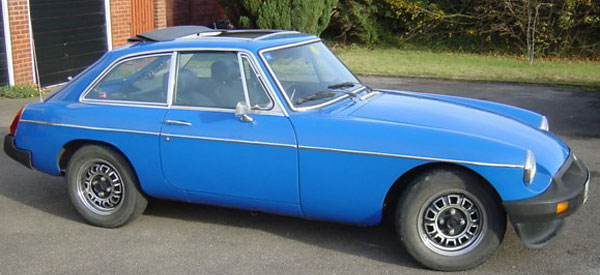
�
Bob Fisher's MGB GT V8 (bought in Great Britain and brought to U.S.A.)
�
�
Specification Comparison
�| MGB GT | MGC (roadster) | MGB GT V8 | ||
| SPECIFICATIONS | ||||
| Cylinders | 4 in line | 6 in line | V8 | |
| Bore / stroke, mm | 80.2 x 88.9 | 83.3 x 88.9 | 88.9 x 71.1 | |
| Capacity, cc | 1,798 | 2,912 | 3,528 | |
| Valves | ohv | ohv | ohv | |
| Bhp / rpm | 95 / 5,400 | 145 / 5,520 | 137 / 5,000 | |
| Lb.ft. / rpm | 110 / 3,000 | 170 / 3,500 | 193 / 2,900 | |
| Transmission* | 4-speed + o/d | 4-speed + o/d | 4-speed + o/d | |
| Front Sus. | wishbones, coils | wishbones, tor. bars | wishbones, coils | |
| Rear Sus. | live axle, leafs | live axle, leafs | live axle, leafs | |
| Weight cwt | 20.8 | 22.2 | 21.2 | |
| PERFORMANCE | ||||
| Max speed, mph | 107.6 | 118.2 | 125.3 | |
| 0-60 mph, sec. | 11.6 | 10.0 | 7.7 | |
| 30-50 (4th), sec. | 8.8 | 9.4 | 6.2 | |
| 50-70 (4th), sec. | 13.1 | 11.7 | 6.3 | |
| Overall, mpg | 27.4 | 19.3 | 19.8 | |
| Touring, mpg | 33.0 | 25.6 | 25.7 | |
| Test Year | 1970 | 1967 | 1973 | |
| PRODUCTION | ||||
| Years | 1962-80** | 1967-69 | 1972-76 | |
| Numbers | 513,626 | 8,999 | 2,591 | |
| *as tested by Motor. | **all MGB's. | |||
�
�
The V8 was in every way a better car than the MGC. Its compact engine sat well back in the �
monocoque, so the "B's" normal wishbone suspension was retained. (the long engine of the �
nose-heavy "C" dictated a front-end redesign utilizing torsion bar springs). The 320lb engine �
was 40 lb lighter than the all-steel "B's", a whopping 240 lb less than the jumbo sized "C's" �
so it didn't upset the car's balance. What's more, its smoothness and output lifted the car �
into a new league.�
�
Costello had used the "B" gearbox, stretched beyond the limit by the increased torque. MG �
wisely opted for the stronger "C" box and, playing very safe, a low compression (8 25:1) �
engine like that used in the Range Rover. With 137 bhp, the GT-only BV8 was actually not �
as powerful as the 145 bhp "C", but because it weighed less and developed much more torque �
(193 lb ft at 2,900 rpm against the "C's" 170 at 3,500), it was appreciably faster and handled �
much better. With the SD1 10.25:1 engine, it would have rivaled the performance of the much �
more expensive Jaguar E-Type, still in production when the B was launched. Jaguar might have �
been even more displeased by an MG that outran their XJS, launched in September 1975, a year �
before the V8 was dropped. (It's encouraging to see that BL's present top brass see things in �
a different light, otherwise the new Rover Vitesse might never have happened.)�
�
The first 1,072 V8s made had chrome grilles and bumpers. The rest were rubber-snouted to comply �
with US safety regulations. Stiffer rear springs and fatter 175 section tyres carried on �
attractive light-alloy wheels made even the early V8s ride a little above the normal BGT. To �
avoid the much-criticized bulging bonnet of the "C", a special inlet manifold was devised to �
contain the engine under the standard bonnet.�
�
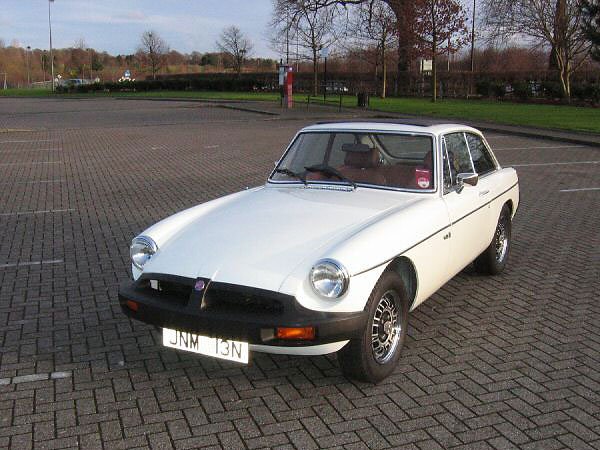
�
On the road
��
Motor's testers (and I was one of them) were evidently in two minds about the BV8 when it was �
assessed in August 1973. "It really is something of an enigma. Does one regard it as an uprated �
MGB or as an entirely new car?" The test report was couched in terms that left the reader in no �
doubt that even though the V8 was great to drive it failed to live up to expectations fuelled by �
two years' eager anticipation.�
�
At £2,294 it was considered expensive for a car with: a poor ride ("the vintage nature of the �
suspension really shows up at low speeds''), dated unmodernized cabin ("the dashboard layout �
is rather crude and austere... irritating trivialities outweigh the good points"), inefficient �
heater ("antediluvian controls"), and disagreeable wind rush ("at 70 it is noisy... above this �
speed makes fast runs a misery"). Not even the performance got a five-star rating, though against �
other like-priced rivals it was considered "very respectable".�
�
It was the Ford Capri 3000GT, then costing £1651, that probably tempered Motor's enthusiasm for �
the MG. The Ford's top speed of 120 mph and 0-60 mph acceleration of 8.6 seconds were not that �
far short of the V8's 125 mph and 7.7 seconds. What's more, the Capri was a full four-seater, �
albeit not one then with a hatchback tail. There's no doubt that the MG could have been quicker. �
Whether it needed to be is another matter. As Motor observed, "What the bald figures cannot �
convey is the utter smoothness, refinement, and lack of drama... and the delightful surge when �
accelerating hard. Flexibility is remarkable, and 1,000 rpm in top gear is quite usable in traffic. �
�
Such quotes underscore the BV8's strong suit of effortless speed, it was not a busy flier but �
a potent smoothie which tended to throw into prominence deficiencies in other departments, most �
of them stemming from the car's age. Remember, the MGB was already nearly 10 years old. �
�
Today the flaws which rightly disappointed Motor's testers when the V8 was new nearly a decade �
ago no longer jar. You expect an MG of this vintage to feeI rather dated. You prime yourself �
to accept its shortcomings. It was in this frame of mind that I recently drove a '74 BV8 and �
was very agreeably surprised. The car belongs to Richard Monk who bought it secondhand in 1976 �
for £1,900. He values it now at around £3,500 even though it's in largely original condition �
(in other words, it hasn't been restored), used as everyday transport and has covered over �
100,000 miles without major mechanical overhaul. The engine feels good for another 100,000 �
miles, highlighting one valued quality that Motor's testers couldn't assess on their low-mileage �
demonstrator: longevity. The BV8's lazy, lowly-stressed engine invariably outlives the rather �
rust-prone body, though that of Richard's cosetted black car was in exceptional condition. �
Treated and resprayed sills had arrested corrosion, but small bubbles at the base of the screen �
indicated the need for further attention. �
�
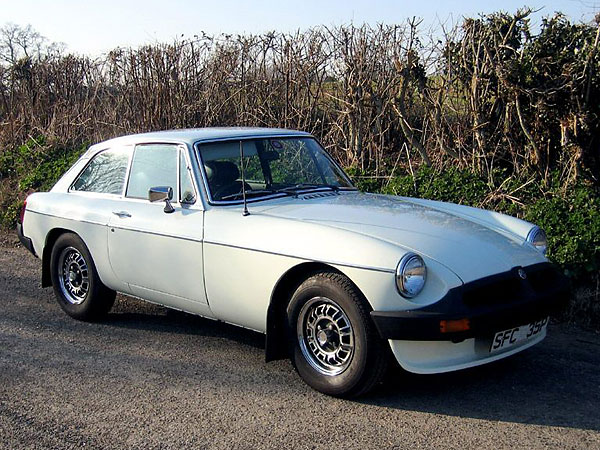
�
�
The interior (which looked virtually brand new) didn't feel so stark and dated as anticipated, �
and the cloth-covered seats were excellent. I'd forgotten just how comfortable they, and the �
relaxed driving position vvere.�
�
Even with the original "agricultural" Range Rover engine, acceleration is strong and clean and �
the gearbox (which displayed no overt signs of wilting after eight year's use) had a much �
sweeter change than the original test car's. Lever movement was light and precise, no longer �
"stiff and notchy" as Motor had described it in 1973. In fact the whole of the drive-train �
felt and sounded in excellent shape, with no sizzle, vibration or clonks to betray wear.�
�
I was also impressed with the car's roadholding and handling, even allowing for the 185-section �
tyres (one size up on standard) fitted by Richard Monk. It clung on well, felt reasonably agile �
(unlike the unwieldy "C") and neither scrubbed its front tyres with excessive understeer nor �
side-slipped its rear ones under provocative power. The car's balance and neutrality made it �
feel very reassuring.�
�
Not even the firm ride seemed quite so harsh as Motor's test had suggested, maybe because of �
the different tyres and non-standard telescopic dampers I could tolerate the crude suspension �
more readily then the awful wind noise which completely drowned the smooth, satisfying burble �
of the engine except at low speed. If a sports car is going to be noisy - and this one is - �
it's got to make the right sort of noise. The tearing, buffeting, whooshing cacophony created �
by the V8's pillars and window frames (and aggravated on this car by a sunshine roof) is an �
objectionable racket. Pity.�
�
If you can accept this and other shortcomings, a BV8 still makes a lot of sense as a fast �
and practical two-seater express. Modern counterparts are likely to set you back three or �
four times as much, and depreciate much faster - even cars like the Porsche 944 (£13,390), �
TVR Tasmin Fixedhead (£13,824), and Lotus Eclat Excel (£13,787). The highly acclaimed �
Capri 2.8i (£8,125) could barely keep in, which underlines just how quick the V8 was in its �
day - and still is now.�
�
Richard Monk asserts that running costs are remarkably low. He reckons to get 30 mpg on a �
long run, driving with restraint, 24-25 mpg in town. Thrash the car hard, though, and you'd �
be lucky to get 18-20 mpg. Although the V8 is in Group 7, fully comprehensive insurance for �
a good-risk driver over 25 years old can be arranged through the MGOC for around £150.�
�
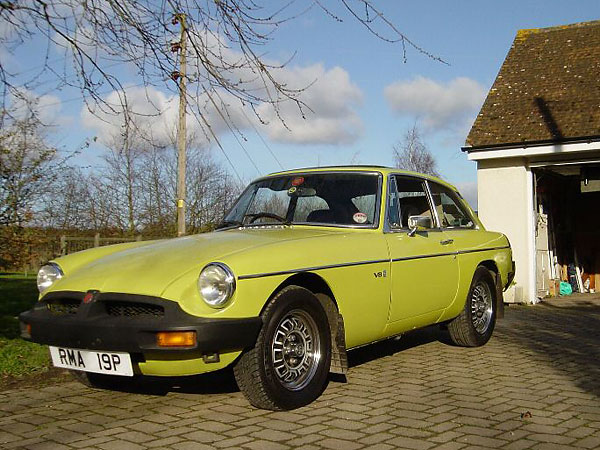
�
Buying a BV8
��
Prices range from £1,700 (scruffy) to over £5,000 (concours). The early chrome-fronted cars �
are more highly prized than the subsequent rubber-bumpered ones though expect to pay more �
for a late, low-mileage R-registered model than an early L-registered one. In the end, �
though, condition rather than age is what really matters. �
�
Bodywork is the same as the BGT's, so look for rust in the usual places - sills, rear wheel �
arches and front wings. Repair sections (as opposed to complete body panels) are available �
through the clubs, so corrosion need not be a killer.�
�
Engines are long-lived (police pursuit BV8s ran for 130,000 miles between overhauls) but �
the hydraulic tappets are likely to become clattery after 60,000 miles. They're fairly easy �
to replace, but remember that there are 16 of them at around £6 each. Overheating can cause �
serious gasket and head-warping trouble but it's very rare, even though the automatic twin �
electric fans are prone to seizure, especially after Winter when they rarely come into play.�
�
Early '73 cars did suffer from gearbox trouble before the internals were beefed up. After �
that, the transmission was not an inherent weakness unless punished. If the overdrive �
(fitted on third and top on early cars, top only on later ones) plays up, it's probably �
caused by the usual solenoid trouble.�
�
Life expectancy of the lever-arm dampers, like those of the "B", is about 18 months. Spax �
telescopic ones (as fitted to Richard Monk's car) are a popular swap as they last longer �
and improve the ride and handling. Wider 185-section tyres, stainless steel exhausts (the �
standard mild-steel ones go in a year), electronic ignition and shorter springs for the �
jacked-up rubber bumpered cars are also accepted modifications.�
�
Spares are generally readily available through the clubs, notable exceptions being the �
chromed alloy wheels (which corrode) and the special rear axle.�
�
�
When Motor published this article, they illustrated it with eight photos of an early �
("chrome bumper") MGB GT V8 bearing license plate "HOH 933L". Unfortunately, our copies �
of these photos aren't suitable for reproduction. We've substituted one Leyland Cars�
publicity photo plus photos from the personal collections of British V8 readers Bob Fisher �
and Jake Voelckers respectively. We're delighted to show off some handsome later-model �
('75 and '76 "rubber bumper") MGB GT V8's.�
�
� BritishV8 Magazine has assembled the largest, most authoritative collection of MG � "MGB GT V8" information you'll find anywhere. Check it out! � Access our � MGB GT V8 article index by clicking here. �
�
